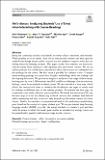| dc.contributor.author | Blobstein, Ariel | |
| dc.contributor.author | Facciotti, Marc T. | |
| dc.contributor.author | Igo, Michele | |
| dc.contributor.author | Karger, David | |
| dc.contributor.author | Ravi, Prerna | |
| dc.contributor.author | Sripathi, Kamali | |
| dc.contributor.author | Gal, Kobi | |
| dc.date.accessioned | 2024-05-13T17:53:11Z | |
| dc.date.available | 2024-05-13T17:53:11Z | |
| dc.date.issued | 2024-05-08 | |
| dc.identifier.issn | 1560-4292 | |
| dc.identifier.issn | 1560-4306 | |
| dc.identifier.uri | https://hdl.handle.net/1721.1/154933 | |
| dc.description.abstract | Emoji are commonly used in social media to convey affects, emotions, and attitudes. While popular in social media, their use in educational contexts has been sparsely studied even though emoji can be a natural way for students to express what they are feeling about the learning material. This paper studies how students use instructor-selected emoji when relating to and engaging with educational content. We use an online platform for collaborative annotations where discussions are embedded into the readings for the course. We also make it possible for students to use 11 unique emoji-hashtag pairings to express their thoughts and feelings about the readings and the ongoing discussion. We provide an empirical analysis of the usage of these emoji-hashtag pairs by over 1,800 students enrolled in different offerings of an introductory biology course from multiple academic terms. We also introduce a heat map, which allows the instructional team to visualize the distribution and types of emoji used by students in different parts of the reading material. To evaluate the heat map, we conducted a user study with five instructors/TAs. We found that instructors/TAs use the heat map as a tool for identifying textbook sections that students find difficult and/or interesting and plan to use it to help them design the online content for future classes. Finally, we introduce a computational analysis for predicting emoji/hashtag pairs based on the content of a given student post. We use pre-trained deep learning language models (BERT) to predict the emoji attached to a student’s post and then study the extent to which this model generated in an introductory biology course can be generalized to predict student emoji usage in other courses. | en_US |
| dc.publisher | Springer Science and Business Media LLC | en_US |
| dc.relation.isversionof | 10.1007/s40593-024-00401-5 | en_US |
| dc.rights | Creative Commons Attribution | en_US |
| dc.rights.uri | https://creativecommons.org/licenses/by/4.0/ | en_US |
| dc.source | Springer New York | en_US |
| dc.title | #let’s-discuss: Analyzing Students’ Use of Emoji when Interacting with Course Readings | en_US |
| dc.type | Article | en_US |
| dc.identifier.citation | Blobstein, A., Facciotti, M.T., Igo, M. et al. #let’s-discuss: Analyzing Students’ Use of Emoji when Interacting with Course Readings. Int J Artif Intell Educ (2024). | en_US |
| dc.contributor.department | Massachusetts Institute of Technology. Computer Science and Artificial Intelligence Laboratory | |
| dc.identifier.mitlicense | PUBLISHER_CC | |
| dc.eprint.version | Final published version | en_US |
| dc.type.uri | http://purl.org/eprint/type/JournalArticle | en_US |
| eprint.status | http://purl.org/eprint/status/PeerReviewed | en_US |
| dc.date.updated | 2024-05-12T03:12:00Z | |
| dc.language.rfc3066 | en | |
| dc.rights.holder | The Author(s) | |
| dspace.embargo.terms | N | |
| dspace.date.submission | 2024-05-12T03:12:00Z | |
| mit.journal.volume | International Journal of Artificial Intelligence in Education | en_US |
| mit.license | PUBLISHER_CC | |
| mit.metadata.status | Authority Work and Publication Information Needed | en_US |
